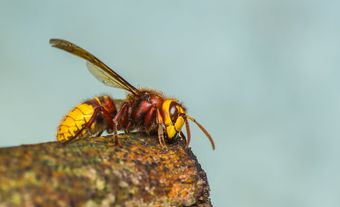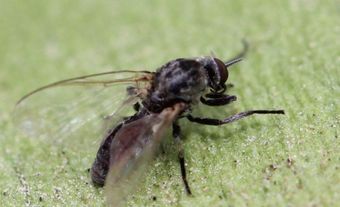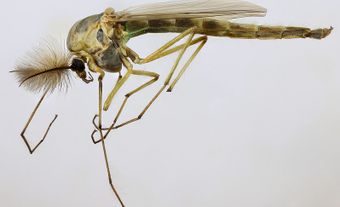Cicadas are large, sound-producing insects in the family Cicadidae, best known for their multi-year life cycles. They are true bugs, belonging to the order Hemiptera. Scientists know of more than 3,200 species of cicada worldwide, most of them from the tropics. In Canada, scientists have recorded 21 species, found in forested areas across the country and as far north as Sambaa Deh Falls Territorial Park, Northwest Territories. The loud, distinctive calls of males are heard on warm summer days, and are unique to each species. Cicada species are either annual or periodical, depending on their life cycle. While annual species are seen each year, periodical species emerge in 13- or 17-year cycles. Only annual species of cicada are found in Canada.

Description
Cicadas are large insects, approximately 25–50 mm long, with wide-set eyes and short antennae. Most of North America’s annual species are black with greenish or orange markings. Periodical cicadas of the Eastern United States have red eyes and orange wing veins. Cicadas have long, sturdy beaks that extend backwards beneath their body, used to pierce roots and twigs to consume sap (xylem). Nymphs live underground and resemble wingless, brownish adults with large, shovel-like front legs for digging through the soil.
Did you know?
Entomologists use the word “bug” specifically for insects in the order Hemiptera, like cicadas, bed bugs and aphids. They are often called “true bugs” to differentiate them from the rest of the insects, and from other terrestrial arthropods like spiders, millipedes, and isopods, all of which can be colloquially called “bugs.”
Distribution and Habitat
Cicadas are found around the world, mainly in forests and grasslands. They typically have large geographic distributions. In Canada, cicadas are mostly found in temperate areas in southern portions of the country, although one species, the Canadian cicada ( Okanagana canadensis), is found in the Northwest Territories. In Eastern Canada, the most commonly encountered species is the common dog day cicada (Neotibicen canicularis).
Reproduction and Development
Cicadas have unusually long life cycles for insects, ranging from 2 to 17 years. They spend most of their lives underground as juveniles. Adults live for only about a month, just long enough to mate and lay eggs. Adult male cicadas sing from treetops on warm summer days to attract females. After they mate, females use their sharp ovipositors to cut into living or dead twigs of trees, where they lay their eggs. Eggs hatch after about four to six weeks, or else during the following spring. The tiny nymphs fall to the ground, burrow into the soil, and begin sucking sap from the roots of trees and other woody plants. Freshly hatched nymphs are only a few millimeters in length, but will spend several years feeding and growing until they reach adult sizes. Nymphs molt their exoskeletons four times before they emerge from the soil, climb up a tree or other object, and molt one more time into the adult stage. Their molted exoskeletons can often be found still clinging to trees in mid-summer.
Annual and Periodical Cicadas
Most cicadas are so-called annual species, referring to the fact that at least some individuals emerge each summer. In comparison, the periodical cicadas synchronize their emergence to 13- or 17-year cycles, depending on the species. These species belong to the genus Magicicada, and are found exclusively in the Eastern United States,. Periodical cicadas occur in different regional “broods,” each consisting of one or more species with the same cycle length. Adults of all species in a given brood emerge all at once in great numbers, once every 13 or 17 years. Periodical cicadas have incredibly dense populations, with larger broods reaching up to 3.6 million insects per hectare.
Sound Production
The loud, audible calls of cicadas are unusual among the true bugs. Most other noise-producing insects belong to the order Orthoptera — the crickets, katydids and grasshoppers. Unlike these other insects, cicadas produce sound by vibrating a pair of structures called tymbals, found on the upper side of the body behind the wings. The tymbals consist of a membranous surface sat atop a cavity inside the body, like a tiny pair of drums. Using rapid muscle contractions, the surface of the tymbal is repeatedly warped out of shape, and the resulting noise resonates through the hollow cavity to produce the characteristic call. The same cavities also contain a pair of hearing structures (tympanic membranes) to detect the calls of other cicadas. Cicada calls are so loud that they can be heard up to 2.4 km away.
Like birds, cicadas species can usually be identified by their call. Cicada calls can vary in cadence, duration, frequency, and structure. Usually, more closely-related species have less similar songs, to avoid mating with members of the wrong species.
Ecology
Cicadas are herbivorous insects that feed on the sap (xylem) of their host plants, most of which are trees and wild grasses. Adults feed from twigs, while nymphs feed from roots. Although their impact on the host plant is generally low, the feeding activity among larger broods of periodical cicadas can reduce the growth of affected trees by up to 30 per cent. Cicadas can also cause damage to trees when they lay eggs in living twigs, which usually results in the twig dying beyond the point where the eggs are laid.
The multi-year life cycles of cicadas may have evolved as a way of avoiding long, cold periods during glaciations of the past. Their long life cycles also help them avoid predators and parasitoids, especially those of periodical cicadas. For one thing, emerging in such great numbers means that an individual’s risk of predation is very low. For another, the life cycles of predators, for example birds, mammals, or other insects, do not regularly coincide with the 13- and 17-year cycles of periodical cicadas.

Relationship with Humans
Annual cicadas cause little damage and are not usually considered pests, but periodical cicadas can sometimes cause considerable damage in tree nurseries during emergence years. Most people’s interactions with cicadas involve noticing their loud calls on warm summer days. In particular, the constant, buzzy call of the common dog day cicada (Neotibicen canicularis) is sometimes wrongly attributed to overhead power lines. In addition to being a sign of summer, cicadas have been present in symbology throughout history and around the world. Cicadas can also be eaten as food, especially the freshly-emerged adults, whose bodies are still soft.

 Share on Facebook
Share on Facebook Share on X
Share on X Share by Email
Share by Email Share on Google Classroom
Share on Google Classroom



